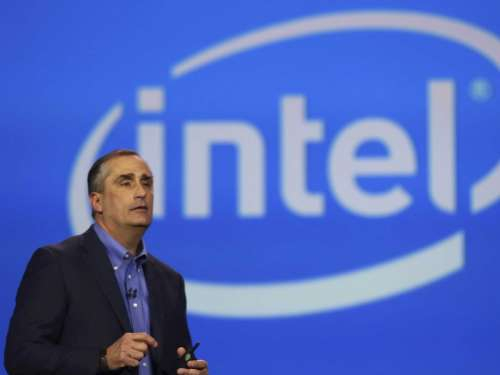 Intel has a new division that combines its computer and mobile businesses – Client Computing Group. Previously, these were two separate divisions. When the company announced this decision, many analysts expressed surprise. More than half of Intel's revenues usually come from the computer side of the business, while its mobile business is significantly less profitable. Last year, the company suffered a $4.2 billion loss due to the Mobile & Communications Group.
Only now, Intel CEO Brian Krzanich explained why the company decided to take such a decisive step to change its structure.
According to him, the most important reason was customer demand. Intel analysts have noticed that more and more customers view all their platforms as the same type of equipment. Combining the two groups will make the devices more convenient for Intel customers.
Another reason for the merger is engineering. Krzanich said that Intel wants to reduce the number of differences between a computer and a mobile phone, including in software and in some of the main components of the devices. The reform of the structure will only increase the efficiency of the company's business.
“Our customers and our desire for efficiency are the main reasons for this decision,” Krzanich said. “There’s no other reason.”
Intel CFO Stacey Smith added that the move also makes more sense from a revenue perspective, since some of the company’s partners classify Microsoft’s 2-in-1 devices as “tablets,” while others would classify them as PCs. “We’re seeing the lines between different devices blur,” she said. The new structure would also allow Intel to salvage its mobile business.
Intel is also reportedly looking to acquire a company called Altera for more than $13 billion, which would be Intel’s largest deal in the company’s history. Krzanich declined to comment on the matter.
Intel has had steady revenue so far. Its first-quarter profit was $12.8 billion. The company’s shares have risen about 2% over the past three months.
Intel has a new division that combines its computer and mobile businesses – Client Computing Group. Previously, these were two separate divisions. When the company announced this decision, many analysts expressed surprise. More than half of Intel's revenues usually come from the computer side of the business, while its mobile business is significantly less profitable. Last year, the company suffered a $4.2 billion loss due to the Mobile & Communications Group.
Only now, Intel CEO Brian Krzanich explained why the company decided to take such a decisive step to change its structure.
According to him, the most important reason was customer demand. Intel analysts have noticed that more and more customers view all their platforms as the same type of equipment. Combining the two groups will make the devices more convenient for Intel customers.
Another reason for the merger is engineering. Krzanich said that Intel wants to reduce the number of differences between a computer and a mobile phone, including in software and in some of the main components of the devices. The reform of the structure will only increase the efficiency of the company's business.
“Our customers and our desire for efficiency are the main reasons for this decision,” Krzanich said. “There’s no other reason.”
Intel CFO Stacey Smith added that the move also makes more sense from a revenue perspective, since some of the company’s partners classify Microsoft’s 2-in-1 devices as “tablets,” while others would classify them as PCs. “We’re seeing the lines between different devices blur,” she said. The new structure would also allow Intel to salvage its mobile business.
Intel is also reportedly looking to acquire a company called Altera for more than $13 billion, which would be Intel’s largest deal in the company’s history. Krzanich declined to comment on the matter.
Intel has had steady revenue so far. Its first-quarter profit was $12.8 billion. The company’s shares have risen about 2% over the past three months.
 Intel has a new division that combines its computer and mobile businesses – Client Computing Group. Previously, these were two separate divisions. When the company announced this decision, many analysts expressed surprise. More than half of Intel's revenues usually come from the computer side of the business, while its mobile business is significantly less profitable. Last year, the company suffered a $4.2 billion loss due to the Mobile & Communications Group.
Only now, Intel CEO Brian Krzanich explained why the company decided to take such a decisive step to change its structure.
According to him, the most important reason was customer demand. Intel analysts have noticed that more and more customers view all their platforms as the same type of equipment. Combining the two groups will make the devices more convenient for Intel customers.
Another reason for the merger is engineering. Krzanich said that Intel wants to reduce the number of differences between a computer and a mobile phone, including in software and in some of the main components of the devices. The reform of the structure will only increase the efficiency of the company's business.
“Our customers and our desire for efficiency are the main reasons for this decision,” Krzanich said. “There’s no other reason.”
Intel CFO Stacey Smith added that the move also makes more sense from a revenue perspective, since some of the company’s partners classify Microsoft’s 2-in-1 devices as “tablets,” while others would classify them as PCs. “We’re seeing the lines between different devices blur,” she said. The new structure would also allow Intel to salvage its mobile business.
Intel is also reportedly looking to acquire a company called Altera for more than $13 billion, which would be Intel’s largest deal in the company’s history. Krzanich declined to comment on the matter.
Intel has had steady revenue so far. Its first-quarter profit was $12.8 billion. The company’s shares have risen about 2% over the past three months.
Intel has a new division that combines its computer and mobile businesses – Client Computing Group. Previously, these were two separate divisions. When the company announced this decision, many analysts expressed surprise. More than half of Intel's revenues usually come from the computer side of the business, while its mobile business is significantly less profitable. Last year, the company suffered a $4.2 billion loss due to the Mobile & Communications Group.
Only now, Intel CEO Brian Krzanich explained why the company decided to take such a decisive step to change its structure.
According to him, the most important reason was customer demand. Intel analysts have noticed that more and more customers view all their platforms as the same type of equipment. Combining the two groups will make the devices more convenient for Intel customers.
Another reason for the merger is engineering. Krzanich said that Intel wants to reduce the number of differences between a computer and a mobile phone, including in software and in some of the main components of the devices. The reform of the structure will only increase the efficiency of the company's business.
“Our customers and our desire for efficiency are the main reasons for this decision,” Krzanich said. “There’s no other reason.”
Intel CFO Stacey Smith added that the move also makes more sense from a revenue perspective, since some of the company’s partners classify Microsoft’s 2-in-1 devices as “tablets,” while others would classify them as PCs. “We’re seeing the lines between different devices blur,” she said. The new structure would also allow Intel to salvage its mobile business.
Intel is also reportedly looking to acquire a company called Altera for more than $13 billion, which would be Intel’s largest deal in the company’s history. Krzanich declined to comment on the matter.
Intel has had steady revenue so far. Its first-quarter profit was $12.8 billion. The company’s shares have risen about 2% over the past three months.


